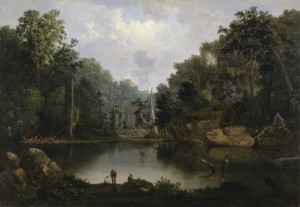![An adult male Rufous hummingbird. [Photo by Allen Chartier / Great Lakes Hummernet / Michigan Radio]](https://www.ghostturtles.com/wp-content/uploads/2013/10/rufous_hummingbird_06-300x199.jpg)
An adult male Rufous hummingbird. [Photo by Allen Chartier / Great Lakes Hummernet / Michigan Radio] See other photos documenting Ohio/Michigan sightings.
- It’s getting colder, but hummingbirds haven’t left the state yet | Michigan Radio 102413
With the chill in the air now, you might guess that most hummingbirds would have ditched Michigan for a more tropical place. The Ruby-throated hummingbird is the bird you’re most likely to see in Michigan, and it has flown south, for the most part. But Allen Chartier still wants you to keep an eye out on your backyard feeders.He studies hummingbirds and he’s the project director for Great Lakes Hummernet. “The chances that what you’re looking at is a Ruby-throat is about 50/50, because there are western species that start showing up.” He says you might get a chance to see a Rufous hummingbird.
- Great Lakes HummerNet Home Page
The Great Lakes HummerNet is a project designed to learn more about hummingbirds in the Great Lakes region by enlisting the help of volunteer observers throughout the state. That’s you! The project is in the beginning stages and will be fine-tuned as it progresses.
- Pulvinar neurons reveal neurobiological evidence of past selection for rapid detection of snakes | PNAS 102813
Snakes and their relationships with humans and other primates have attracted broad attention from multiple fields of study, but not, surprisingly, from neuroscience, despite the involvement of the visual system and strong behavioral and physiological evidence that humans and other primates can detect snakes faster than innocuous objects. Here, we report the existence of neurons in the primate medial and dorsolateral pulvinar that respond selectively to visual images of snakes. Compared with three other categories of stimuli (monkey faces, monkey hands, and geometrical shapes), snakes elicited the strongest, fastest responses, and the responses were not reduced by low spatial filtering. These findings integrate neuroscience with evolutionary biology, anthropology, psychology, herpetology, and primatology by identifying a neurobiological basis for primates’ heightened visual sensitivity to snakes, and adding a crucial component to the growing evolutionary perspective that snakes have long shaped our primate lineage. [PNAS-2013-Van Le-1312648110.pdf]
- Eeek, Snake! Your Brain Has A Special Corner Just For Them : Shots – Health News : NPR 102813
Anthropologist Lynne Isbell was running through a glade in central Kenya in 1992 when something suddenly caused her to freeze in her tracks. “I stopped just in front of a cobra,” she says. “It was raised with its hood spread out.” | Isbell, who is at the University of California, Davis, says she has spent the past couple of decades trying to understand how she could have reacted before her conscious brain even had a chance to think — cobra! | “At first I thought it was luck,” she says. “But now I’m pretty sure that it’s not luck. It’s a reflection of 60 million years of evolutionary history working on my visual system.” | The answer involves monkeys, the evolution of primate vision and a part of the brain called the pulvinar, which Isbell in Monday’s Proceedings of the National Academy of Sciences. | In the years after her encounter with the cobra, Isbell developed a theory that snakes are a major reason that humans and other primates evolved really good vision. | “We have our forward-facing eyes,” she says. “We have our excellent depth perception. We have very good visual acuity, the best in the mammalian world. We have color vision. So there has to be some sort of explanation for it.” | Primates in parts of the world with lots of poisonous snakes evolved better vision than primates elsewhere, found out. It’s no accident that lemurs in Madagascar have the worst vision in the primate world, she says. There are no venomous snakes.
- NPR.org » Shortage Of Workers Hampers Chili Harvest In New Mexico 101313
Let’s talk chili peppers. It’s harvest time in New Mexico where the iconic crop has been grown for centuries. New Mexico still produces more chili peppers than any other American state. But production in the U.S. is a fraction of what’s produced in India and China, countries with large pools of labor.


![Sandhill cranes land on Platte River sandbar roosts west of Rowe Sanctuary’s Iain Nicolson Audubon Center southwest of Gibbon, Nebraska. [Photo by Lori Porter| Kearney Hub]](https://www.ghostturtles.com/wp-content/uploads/2015/03/sandhill_cranes_kearneyhub_032015-300x225.jpg)
![An endangered Whooping crane takes flight. Yhe large bird has a 7-foot wingspan. It is all white except for black wing tips and face markings. In this photo its long neck stretches forward; its wings sweep upward; and its black legs trail straight behind it. [Source: International Crane Foundation]](https://www.ghostturtles.com/wp-content/uploads/2023/03/Whooping-crane-eastern-ICF-080622-300x157.jpg)

![Mark Willis peruses a 1745 volume by Voltaire at a bouquiniste book stall on the banks of the Seine in Paris. He wears a brown leather jacket and checkered flat cap. He holds the open book in his hands. Rows of old books are seen on shelves behind him. [2005 photo by Ms. Modigliani]](https://www.ghostturtles.com/wp-content/uploads/2023/03/mw_bouquiniste_05-300x225.jpg)


